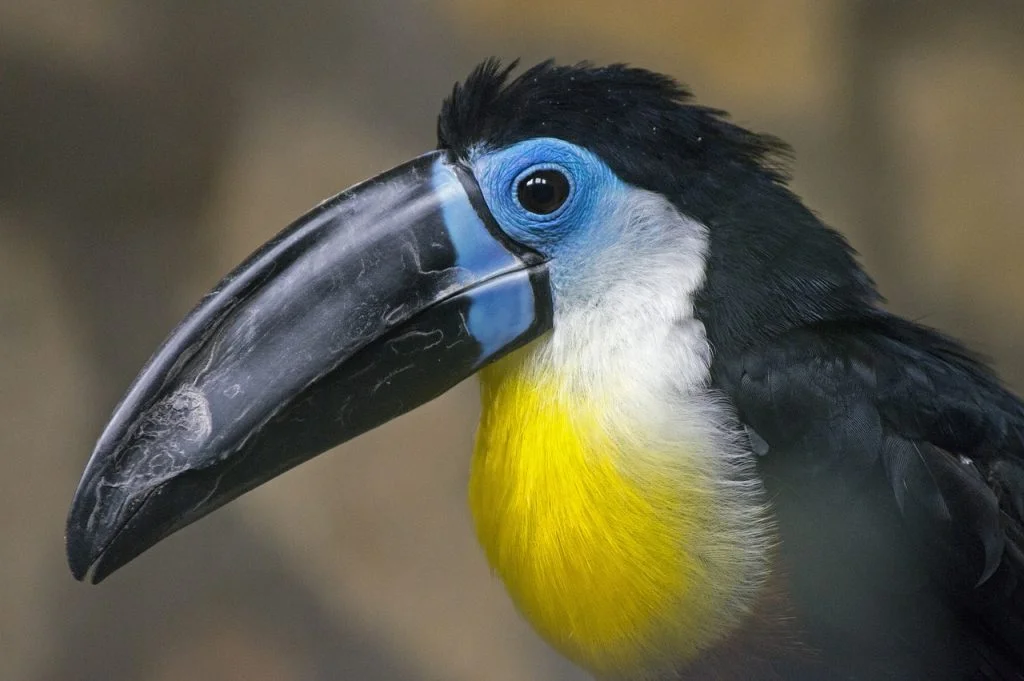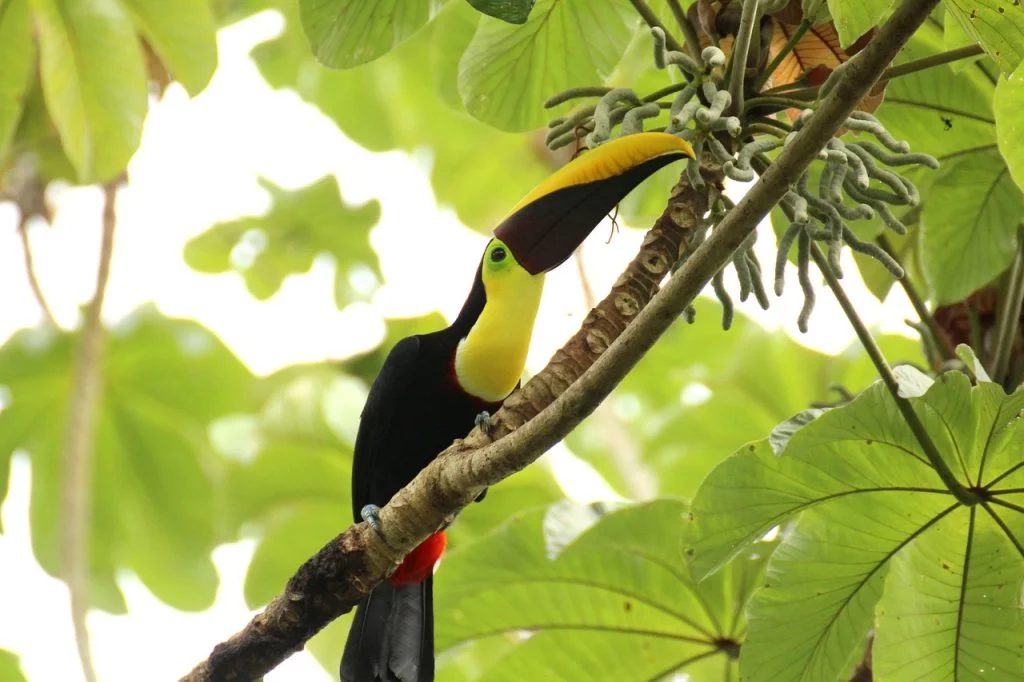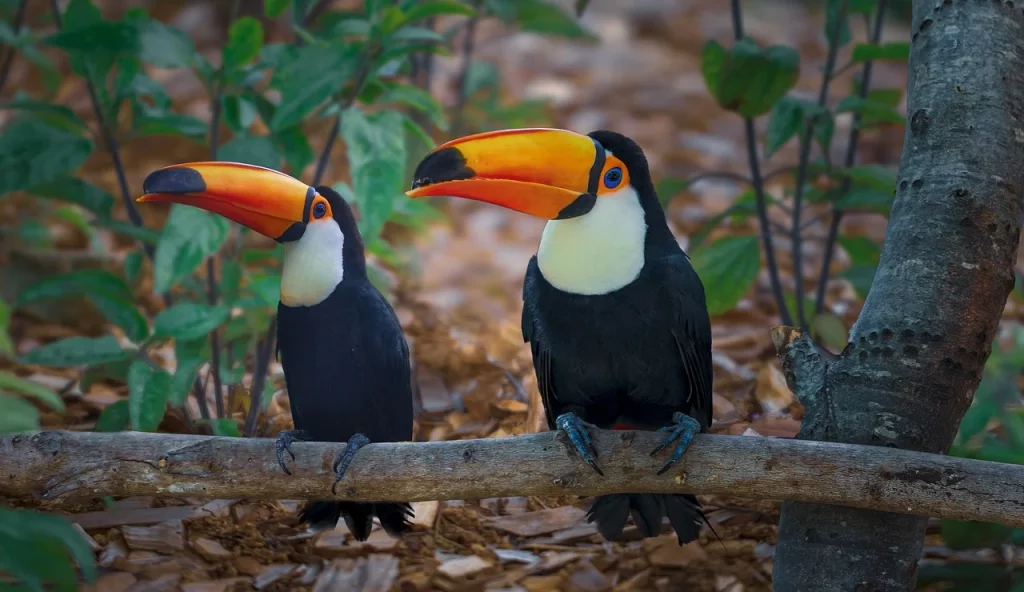Step right up and behold the toucan, the bird with a beak so large, it could have its own zip code! In the lush theaters of the rainforests, these birds are the headlining act, flaunting beaks that seem to defy the laws of physics.
But it’s not all about looks in the toucan world – these beaks are like Swiss Army knives, just a lot less pocket-friendly. Have you ever wondered if toucans get tired of carrying around their massive beaks? Well, let’s delve into the vibrant and sometimes comical life of toucans, where each fact unfolds like a chapter in a fascinating story.
Toucans, the painters of the rainforest, splash the canopy with their vibrant colors.
Unknown
Toucan Facts
Let’s explore their vibrant and mysterious lives together! As you read these fascinating facts about toucans, remember, there’s a quiz at the end of this article. You have to prove to me that you are a master on this topic, so read carefully.
- Toucans are known for their large, colorful bills, which can measure up to half the length of their body.
- Their vibrant beak colors can include combinations of black, red, white, and yellow.
- Toucans are native to the tropical forests of Central and South America.
- There are about 40 different species of toucans.
- Their diet mainly consists of fruit, but they also eat insects and small animals.
- Toucans play a vital role in seed dispersal for tropical plants.
- Their long tongues can reach up to 6 inches in length, aiding in their feeding.
- Toco Toucan is the largest species, with its bill reaching up to 8 inches.
- Nesting typically occurs in tree cavities.
- They are social birds, often seen in small flocks.
- Toucans have zygodactyl feet – two toes pointing forward and two backward.
- Despite their large bills, they are surprisingly light due to their hollow structure.
- Their bill regulates body temperature, acting as a thermal radiator.

- Keel-billed Toucan is also known as the “rainbow toucan” due to its colorful bill.
- Channel-billed Toucans have the longest bill relative to body size.
- Toucans are nocturnal in nature, active mostly at night.
- They are poor fliers, relying on hopping and gliding between trees.
- Their calls can sound like croaks, rattles, and squawks.
- Toucans have a lifespan of approximately 20 years in the wild.
- Breeding pairs are monogamous, often staying together for life.
- Babies are born with small, normal-sized beaks.
- Deforestation is a significant threat to their natural habitat.
- Some species of toucans are endangered due to habitat loss and the pet trade.
- Toucans are popular in folklore and culture in their native regions.
- Toucans are a symbol of playfulness and intelligence in native mythology.
- Keel-billed Toucans are the national bird of Belize.
- They are frugivores, mainly eating fruits from various tropical trees.
- Captive toucans can be fed a diet of special pellets, fruits, and insects.

- Their beaks are not very strong and are used more for feeding than for defense.
- Their colorful appearance makes them a target for illegal pet trade.
- Toucan Sam, the mascot of Froot Loops cereal, is a well-known toucan character.
- They have excellent vision, aiding in their search for food.
- Despite their appearance, they are not closely related to hornbills.
- Toucans can be territorial, especially during the breeding season.
- Their nests are usually located in tree hollows or abandoned woodpecker holes.
- Both parents participate in raising the young.
- Young toucans do not have the full coloration of adults until their first year.
- Environmental changes and climate change pose threats to their survival.

- They use their beaks to reach and skin fruit that is otherwise inaccessible.
- Some species of toucans have patches of brightly colored skin around their eyes and throats.
- Their wings are short and rounded, making them suitable for quick flights in dense forests.
- Chestnut-mandibled Toucan is known for its deep, melodious calls.
- Their feathering often includes striking contrasts of black with bright colors.
- Spot-billed Toucans have spots on their bills, unique to their species.
- During courtship, toucans often exchange and toss fruit to each other.
- Their large bill can intimidate predators and rivals.
- Toucans can be found at elevations up to 6,500 feet in the Andes.
- Mountain Toucans have shorter bills adapted to colder climates.
- Their feet are adapted for grasping, not walking.
- Citron-throated Toucans have striking yellow throats and are found in Central America.
Toucan Myths

I hope you learn something new from these facts. Now it’s time to uncover some popular myths about these iconic birds.
- Toucans Can Talk Like Parrots
Unlike parrots, toucans can’t mimic human speech. They do have a unique range of vocalizations, but it’s more like croaking and barking than chatting with us! - Toucans Eat Mainly Fruits
It’s true that fruits are a big part of their diet, but toucans are opportunistic eaters. They also snack on insects, small birds, and eggs, showing their less-discussed carnivorous side. - Toucans’ Beaks are Heavy
Despite their large size, toucan beaks are surprisingly light. They’re made of keratin (like our hair and nails) with a honeycomb structure inside. It’s like carrying around a big, lightweight accessory! - Toucans are Great Flyers
Toucans are more about style than distance when it comes to flying. They’re not the best flyers and prefer to hop around branches. Think of them as the hopping fashionistas of the bird world! - Toucans Change Beak Color With Mood
Although it’s a charming idea, toucans’ beaks don’t change color with mood. Their beak color is static, but it sure does make them stand out in the birdie crowd!
No products found.
Toucan FAQ

Curious for more? Let’s hop into the FAQ section to explore deeper. And don’t forget, a fun quiz is just around the corner, so read with an eagle eye!
- Are Toucans Endangered?
Toucans are not universally endangered, but their status varies by species. Some species, like the Keel-billed Toucan, are of ‘Least Concern‘, while others, such as the Toco Toucan, are considered ‘Vulnerable‘. Habitat loss and pet trade are significant threats to their populations. - Can Toucans Talk?
Toucans cannot mimic human speech. They are known for their own unique vocalizations, which can be quite loud. These sounds are more like croaks and rattles than the words and phrases that parrots replicate. - What Do Toucans Eat?
Toucans primarily eat fruit, which makes up the bulk of their diet. However, they are opportunistic feeders and can also consume insects, small birds, and bird eggs when available. Their large beaks are perfect for peeling and eating fruits. - Are Toucans Good Pets?
Keeping toucans as pets is a big responsibility and not recommended for everyone. They require a special diet, a large space to live, and are not domesticated like dogs or cats. Toucans are wild animals and may have specific needs that can be challenging to meet in a home environment. - How Long Do Toucans Live?
In the wild, toucans can live for about 20 years, but in captivity, with proper care, they can live up to 25 years or more. Their lifespan depends significantly on the quality of their diet, environment, and overall care.
Toucan Trivia

Dive into the world of toucans with my quiz! But here’s a twist: if you don’t get any right, a toucan may mistake you for a tree branch and perch on your head!
Conclusion
As we bring our toucan tale to a close, we’re left with a deeper appreciation for these extraordinary birds. Their vivid colors, remarkable beaks, and intriguing behaviors are just the tip of the iceberg. Toucans are a testament to the diversity and complexity of our natural world, serving as both symbols of the tropics and key players in their ecosystems.
Their presence enriches our planet in ways we’re just beginning to understand. So, as we bid farewell to these feathered friends, let’s ponder a final thought: Which fact about toucans surprised you the most, and why?
4 Sources Used For This Article10 Amazing Facts about Toucans – Humming Birds Plus
Why Are Toucans’ Beaks So Big? – Bird Spot
Toucan Fact Sheet – PBS


